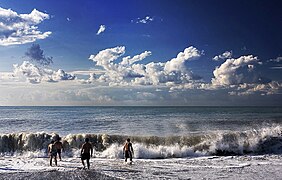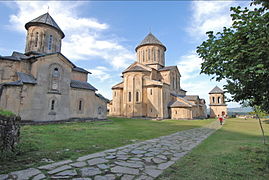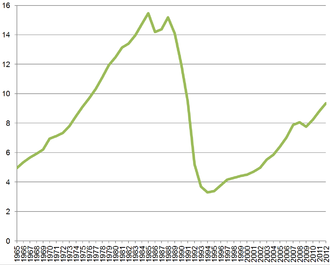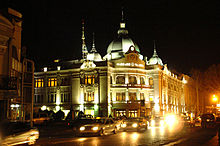Economy of Georgia
| Georgia | |
|---|---|

|
|
| World economic rank | 112th (nominal) (2013) |
| currency | lari |
| Conversion rate | 3.8291 Lari = € 1 |
| Trade organizations |
WTO , GUAM , SMWK , EBRD , World Bank , IMF , DCFTA |
| Key figures | |
|
Gross domestic product (GDP) |
$ 16.53 billion nominal (2014) $ 35.61 billion PPP (2014) |
| GDP per capita |
$ 3,789 nominal (2014) $ 9,630 PPP (2014) |
| GDP by economic sector |
Agriculture : 8.97% Industry : 24.89% Services : 66.14% (2016) |
| growth | 4.8% (2014) |
| inflation rate | 2.5% (April 2015) |
| Gini index | 41.4 |
| Employed | 1.7799 million (2015) |
| Activity rate | 88.0% (2015) |
| Unemployed | 0.2416 million (2015) |
| Unemployment rate | 13.9% (2017) |
| Foreign trade | |
| export | $ 3.533 billion (2017) |
| Export goods | Scrap metal, machinery, electricity, chemicals, wood, fuel re-export, citrus fruits, tea, wine |
| Export partner | (2016) |
| import | $ 7.846 billion (2017) |
| Import goods | Fuel, machinery and spare parts, transportation equipment, grain and other food, pharmaceuticals |
| Import partner | (2016) |
| Foreign trade balance | $ -4.316 billion (2017) |
| public finances | |
| Public debt | $ 5.2 billion 31.5% of GDP (2014) |
| Budget balance | + 0.2% of GDP (2015) |
The economy of Georgia turns traditionally around the tourism on the Black Sea , the cultivation of citrus fruits , grapes, tea , reduction of manganese and copper , as well as the yield of a small industrial sector, wine , metals , machinery , chemicals and textiles produced. The country now produces most of its energy needs through hydropower itself, and Georgia has to import natural gas and oil products . Its only significant internal energy resource is hydropower.
According to the 2017 World Economic Forum's Global Competitiveness Index, Georgia ranks 67th (out of 137) of the most competitive countries in the world. In the index for economic freedom , the country ranks 13th out of 180 countries (2017).
history
Viticulture has a very long tradition in Georgia . Wine has been exported since at least the 6th century BC. BC Already in the 3rd century BC Georgia was the armory of antiquity . In Caucasus mountains were gold , silver , copper and iron and its alloys degraded. Georgian artisans made the swords that Greeks and Trojans fought with. Trade was not common among Georgians: traders were mostly Armenians for many centuries.
In Soviet times, the Georgian Soviet Socialist Republic was considered the one with the best living conditions. Western observers called the country the Switzerland of the Caucasus . The subtropical climate enabled a rich harvest of agricultural products. Georgia was almost the sole supplier of citrus fruits and tea in the Soviet Union (USSR) . Georgian wine found strong sales. The vineyard area increased from 1950 to 1985 from 58,000 to 128,000 hectares. Annual wine production was 800,000 tons in the mid-1980s. Cattle were raised in the west of the country and sheep in the east . The tourism flourished. Holiday homes and sanatoriums were built on the coast and in the mountains. Well-known holiday resorts were Sukhumi , Gagra , Pizunda , Borjomi and Bakuriani . After the Second World War, the heavy and armaments industries expanded .
A distinctive feature of the Georgian economy was the personal secondary economy . Half of the agricultural production was private. 70% of the total and 30% of the citrus harvest was provided by the non-government sector. The productivity of the private sector has always been well above that of the state-owned companies. Outward signs were an increased density of private motor vehicles in Georgia and the intensive travel activity of Georgian farmers who brought their goods to the markets of Russian cities by air.
present

After the dissolution of the USSR, Georgia suffered the worst economic collapse of all Soviet republics. Heavy industry received no more supplies. Aircraft parts, military electronics, electric locomotives, computers, trucks, tea, citrus fruits, wine and manganese found no buyers. Many businesses were shut down. Production in industry and agriculture fell. The production volume slipped to a quarter of the 1989 level by 1994. Unemployment in the capital Tbilisi rose to 40%.
There was also hyperinflation . In 1992 it was 1,339% annually. By 1995 consumer prices rose 7,000 times. In 1993, a coupon currency was introduced in place of the ruble . The rate fell from 1,000 coupons per US dollar to two million coupons per US dollar in just two years .
Aid from the West did not come until 1995 when the International Monetary Fund (IMF) granted Georgia a loan of 206 million US dollars and Germany of 50 million marks. With the support of the IMF and the World Bank , the Lari (GEL) was introduced as the national currency in October 1995 . It remained stable against the US dollar until its devaluation in 1998.
However, economic growth remained weak. Between 1995 and 1997 the production volume rose to about 30% of the level in Soviet times, by 2001 it reached about 35%. In 2006, 38.5% of the population lived below the poverty line , and 13.4% of households were even in extreme poverty. Professors earned $ 15 a month, while civil war refugees received a maximum of $ 5 a month in support. Old-age pensions had not been paid since the beginning of 2003.
Until a few years ago there were still unsolved problems with the power supply. Georgia could not meet its electricity needs on its own and was always dependent on foreign supplies. In 1990, electricity supplies and fuel supplies to the power plants from Russia, Azerbaijan and Turkmenistan were cut off for several years. The company's own electricity generation fell between 1991 and 1994 from 13.4 billion to three billion kilowatt hours. But there were also shutdowns again and again due to debts with suppliers and poor payment behavior of the electricity consumers themselves. Georgia's own power plants then regularly failed due to a lack of capital due to a lack of modernization and maintenance.
Georgia has now left that time behind and the power supply is reliable today. Georgia now covers its own electricity consumption through domestic production, and even more, electricity is now an export item with enormous growth potential.
The annual electricity consumption of Georgia in 2011 was around 11 TWh, a further 1.3 TWh were exported. All neighboring countries are connected to Georgia via high-voltage lines and have electricity from Georgia fed into their grids at times of peak consumption. Russia is now also the country's electricity consumer. The largest consumer of Georgian electricity is Turkey.
Currently around 85 percent of the electricity generated is generated by hydropower, the remaining 15 percent comes from the Gardabani thermal power station . By around 2018, all electricity production in Georgia should be converted to hydropower.
The great potential for hydropower in Georgia is currently only used to an estimated 18 percent. About 300 rivers are available for use, the state defines the potential locations and prepares feasibility and environmental compatibility studies. As of 2012, around 40 power plant projects are in progress, the completion of which should take place between 2014 and 2017. These new power plants with an investment sum of 5.4 billion euros will generate a total of 10 TWh of electricity per year; power generation is therefore expected to almost double by 2018.
The Georgian economy suffered from a large deficit in the state budget in the late 1990s and early 2000s . In 2001, for example, government revenue was only 15% of gross national product. The government failed to collect the taxes at the time . Corruption and nepotism allowed funds to seep away. Constant power outages damaged the industry. Georgia placed its hopes for an economic recovery on the development of an international transport corridor through the Black Sea ports of Poti and Batumi , a large oil pipeline from Azerbaijani Baku via Tbilisi to Ceyhan in Turkey , the Baku-Tbilisi-Ceyhan pipeline , as well as the parallel one trending South Caucasus pipeline intended to transport gas. A growing trade deficit, tax collection problems, corruption, and separatist conflicts darkened the economic picture. Nevertheless, foreign investment was able to spur higher economic growth.
The conflicts, if unsolved, were at least frozen. Corruption has been fought extremely successfully, and Georgia is now regarded as a global role model. The state budget was also consolidated by the 2011 tax reform with a simplified tax system.
One of the main pillars of the Georgian economy, tourism, developed into one of the fastest growing economic sectors, with the number of tourists almost doubling between 2010 and 2014, with unemployment falling from 18.3% in 2009 to 13.9% as of 2017.
| category | 2005 | 2006 | 2007 | 2008 | 2009 | 2010 | 2011 | 2012 | 2013 | 2014 | 2015 | 2016 | 2017 | 2018 | 2019 |
|---|---|---|---|---|---|---|---|---|---|---|---|---|---|---|---|
| Available workforce (in thousands) | 1,982.7 | 1,911.9 | 1,908.7 | 1,944.7 | 1,971.8 | 1,970.9 | 1,988.2 | 2,004.5 | 1,978.6 | 1,984.6 | 2,018.0 | 1,996.2 | 1,983.1 | 1,939.9 | 1,911.2 |
| Employees (in thousands) | 1,683.0 | 1,618.0 | 1,577.3 | 1,597.3 | 1,611.0 | 1,627.8 | 1,643.5 | 1,659.4 | 1,643.4 | 1,694.4 | 1,733.8 | 1,717.3 | 1,706.6 | 1,694.2 | 1,690.2 |
| Unemployed (in thousands) | 299.7 | 293.9 | 331.4 | 347.4 | 360.8 | 343.1 | 344.8 | 345.1 | 335.2 | 290.2 | 284.2 | 278.9 | 276.4 | 245.7 | 221.0 |
| Unemployment rate (in percent) | 15.1 | 15.4 | 17.4 | 17.9 | 18.3 | 17.4 | 17.3 | 17.2 | 16.9 | 14.6 | 14.1 | 14.0 | 13.9 | 12.7 | 11.6 |
structure
Georgia's economic recovery was hampered by devastating civil wars for state power, the regions of Abkhazia and South Ossetia , persistently weak infrastructure, resistance to reform from corrupt and reactionary groups, and the Russian and Asian economic crisis. With loans from the International Monetary Fund and the World Bank, the Georgian government has brought the economy to new growth since 1995: inflation was reduced, the goals set by the IMF were achieved and a stable national currency , the lari, was introduced. The release of the price of bread, the preparation of the second stage for connection to the World Trade Organization ( WTO ), the conclusion of the contract for the oil pipeline from Baku via Tbilisi to Ceyhan on the Mediterranean gave hope for further growth. But the effects of the economic crisis in Russia and Asia thwarted the plan.
Georgia's economy has made progress on structural reforms. All prices and most of the trade have been liberalized, the influence of the state has been curtailed, and further legal reforms are on the agenda. More than 10,500 small companies have been privatized and more than 1,200 medium and large companies have been converted into public companies. The privatization of state-owned companies continues, but is now more closely controlled.
Due to a lack of investment, Georgia's transport and communication infrastructure is in very poor condition. The telecommunication is partially privatized, some still in state hands.
Georgia cannot meet its energy needs itself and is dependent on supplies from abroad. Natural gas is mainly supplied from Russia, and oil from Kazakhstan. Similar to Ukraine, the gas price is a bone of contention with Russia. It threatened Georgia with an increase in gas prices from 2007 onwards . The country is now looking for alternative deliveries from other countries.
In 1998, the Georgian government began to privatize energy distribution and generation. Large parts of the energy market are now in Russian hands. The Russian energy company Itera has majority stakes in eleven Georgian gasworks, including that of the capital TbilGazi . The Russian company RAO Unified Energy Systems owns 75% of the shares in the Tbilisi electricity company Telasi . The Russian Evraz Holding acquired the Wartsiche hydropower plant. In order to give the government more weight in the domestic energy sector, three state-owned companies merged in March 2006 to form the Georgian Oil and Gas Company (GOGC).
Georgia's external debt in 2003 was $ 1.7 billion. 40% of the money came from the World Bank , the International Monetary Fund ( IMF ) and the European Bank for Reconstruction and Development . A further 60% were loaned in bilateral agreements by states of the CIS , especially Turkmenistan .
To encourage and support the reform process, the European donor countries and the USA have agreed to shift the focus of aid from humanitarian projects to technical and institutional development programs. The posting of legal and technical advisors is complemented by training opportunities for parliamentarians, judicial officers and economic advisors. However, Georgia remains dependent on humanitarian aid targeted at people in need.
Agriculture
Agricultural production is slowly recovering from the devastation of the civil war and the structural changes that followed the collapse of the Soviet Union . Livestock production is experiencing a new upswing, even if it is periodically weakened by disease. Domestic grain production is increasing, but requires sustainable political and infrastructural improvements in order to ensure adequate distribution and profits for the farmers. Tea, hazelnuts and citrus fruit production have suffered tremendously as a result of the conflict in Abkhazia , an extremely fertile area. In the case of citrus fruits , in Georgia these are mainly mandarins and clementines , the production volume was now only about a tenth and is still only about a third of the level before 1989, and for tea even only 5%.
| category | 1992 | 1993 | 1994 | 1995 | 1996 | 1997 | 1998 | 1999 | 2000 | 2001 | 2002 | 2003 | 2004 | 2005 | 2006 | 2007 | 2008 | 2009 | 2010 | 2011 | 2012 | 2013 |
|---|---|---|---|---|---|---|---|---|---|---|---|---|---|---|---|---|---|---|---|---|---|---|
| Wine (tons) | 179700 | 162000 | 160000 | 79000 | 78100 | 78100 | 71700 | 71700 | 71700 | 59500 | 57600 | 65300 | 53000 | 87000 | 85000 | 107000 | 90200 | 104300 | 103400 | 110800 | 112700 | 98800 |
| Tea (in tons) | 50000 | 77000 | 61700 | 38500 | 34000 | 33200 | 47234 | 60330 | 24000 | 23000 | 24000 | 24457 | 20000 | 22755 | 6600 | 7500 | 5400 | 5800 | 3500 | 2900 | 2600 | 3300 |
| Citrus fruits (in tons) | 270000 | 86000 | 97600 | 118000 | 86800 | 57100 | 85200 | 56000 | 40000 | 60000 | 33100 | 59200 | 38200 | 122400 | 52200 | 98900 | 55200 | 93600 | 52100 | 54900 | 77000 | 110400 |
Although around 30% of the Georgian economy is agricultural, the crops spoil because the farmers either cannot bring their products to market or they have to pay costs that drive market prices above those of imported goods. With the help of the European Union , Georgia has taken steps to improve the quality and marketing of its traditional mineral water sources . There are more than 2,400 types of mineral water in the country, around 500 of which are known. The water from the health resort Borjomi has been an export hit to Russia, Europe and the USA since 1997.

|

|
|
|
Georgian tea used to be a successful agricultural product and citrus fruit production in Georgia still has growth potential to its old size
|
||
The Georgian wine production , which declined in the 1990s to 100,000 tons, has attracted investors since 1994 and was equipped with modern technology. The wineries caught up with the international level and were able to increase their sales again in recent years. The largest buyer of Georgian wine is Russia (import: 27.3 million US dollars in 2003), followed by Ukraine (3.7 million US dollars) and the USA (1.58 million US dollars). The European Union had not officially recognized Georgian wine until 2003 (imports: US $ 327,000 in 2003). Since February 2004 Georgian wines can be imported into the European Union without restrictions. The Georgian wine industry was hit hard when Russia imposed an import ban in March 2006. The reason was excessive exposure to pesticides and heavy metals . According to the Georgian government, this was a punishment for Georgia's pro-Western political course. Similar restrictions were also imposed on wine from Moldova . A meeting of Georgian President Mikheil Saakashvili with his Russian counterpart Vladimir Putin at the CIS summit in June 2007 brought some relaxation, but did not end the embargo. The chairman of the Russian Chamber of Commerce and Industry, Russia's former Prime Minister Yevgeny Primakov , has now admitted the futility of these sanctions.
tourism
For a long time, tourism in Georgia was on the ground. The secession conflicts in the early 1990s, the Caucasus War in 2008 and the conflict in neighboring Chechnya have deterred many tourists from visiting the traditional ski resorts, health resorts and nature parks in the Caucasus and the Black Sea. During the Soviet era, around 1.6 million tourists came to Georgia every year; in 1999 the figure was only 350,000. Above all, better-off Russian tourists are now traveling to Western European holiday destinations. In 2005, Georgia saw a slight increase in tourists. Mainly Armenians and Ukrainians interested in inexpensive pitches at the Georgian Black Sea coast.
But here too, Georgia has been back on a strong growth path since 2010. The number of foreign guests increased by 21.8% in 2013 compared to the previous year, after growth rates of 55.7% in 2012, 38.9% in 2011 and 35.3% in 2010. 88% of the visitors came by the neighboring countries Turkey, Armenia, Azerbaijan and Russia.
Ski area near Gudauri
Pebble beach on the Black Sea near Batumi
Ananuri - fortress and monastery on the Aragvi River
Gelati monastery complex
| country | 2013 |
|---|---|
|
|
1,600,000 |
|
|
1,280,000 |
|
|
1,080,000 |
|
|
770,000 |
|
|
30,815 |
|
|
208.754 |
| numbers | 2000 | 2005 | 2010 | 2012 | 2013 | 2014 | 2015 | 2016 | 2017 | 2018 |
|---|---|---|---|---|---|---|---|---|---|---|
| International arrivals (in thousands) | 387 | 560 | 2,032 | 4,428 | 5,392 | 5,516 | 5,901 | 6.361 | 6,483 | 7,203 |
| International tourism income (in million US dollars) | 107 | 287 | 737 | 1,565 | 1.916 | 1,972 | 2.117 | 2,370 | 2,971 | 3,518 |
| International tourism income (in% of GDP) | 3.5 | 4.5 | 6.3 | 9.9 | 11.9 | 11.9 | 15.1 | 16.5 | 19.7 | 21.7 |
According to the Ministry for Economic Affairs and Sustainable Development, tourism income rose by 22% year-on-year to around US $ 1.7 billion in 2013.
New economic policy
President Mikheil Saakashvili brought Georgia back on a growth path with economic liberalization. On June 1, 2004, he appointed the Russian entrepreneur Kacha Bendukidze as Minister of Economy. Bendukidze describes his position as ultra-liberal . He declared war on the Soviet mentality in business. He wants to work in Georgia for deregulation of the economy, comprehensive privatization , a reduction in corporate taxes and rapid economic growth .
In June 2004 the government tabled new tax laws that abolish twelve taxes and reduce income taxes . A month later, she named a list of 372 state enterprises and -Besitztümern to be sold between 2004 and 2006, including the State Mint , the Georgian Telekom , the Tbilisi International Airport , the ports of Poti and Batumi , the Aircraft Tbilaviamscheni and Metallurgical Iron - and steel factory Rustavi . Business start-ups have been made much easier by reducing the number of licensed activities from 909 to 159, lowering the cost of redundancies , and reducing the time and cost of registering property.
The first successes are visible. Georgia's tax revenue more than doubled between March 2004 and October 2005. According to an annual World Bank report published in September 2005 , Georgia ranked first in economic reforms in the CIS and second in the world. In 2006, however, there were setbacks: unemployment rose and the inflation rate climbed to 10%, according to the National Bank. Georgia's economic policy reforms in the 2005/06 observation period were expressly praised in the World Bank's “Doing Business 2007” report. The country was able to improve from rank 112 to 37th and is between France (35th) and Spain (39th). However, the relief will primarily benefit international investors; Sustainable promotion of small and medium-sized companies beyond deregulation measures and low flat-rate taxation is not discernible. The functioning microcredit market is an exception.
Georgia has seen high growth rates in recent years. GDP growth in 2007 was estimated at 12%.
Current economic development
| GDP | 2008 | 2009 | 2010 | 2011 | 2012 | 2013 | 2014 | 2015 | 2016 | 2017 |
|---|---|---|---|---|---|---|---|---|---|---|
| nominal, million GEL | 20,743.4 | 24,344.0 | 26,167.3 | 26,847.4 | 29,150.5 | 31,691.6 | 33,921.6 | 38,042.2 | ||
| nominally, million USD | 12,800.5 | 10,767.1 | 11,636.5 | 14,438.5 | 15,846.8 | 16,139.9 | 16,528.5 | 13,959.9 | 14,332.8 | 15,164.5 |
| percentage, real growth | 2.6 | −3.7 | 6.2 | 7.2 | 6.4 | 3.4 | 4.6 | 2.9 | 2.8 | 5.0 |
| per capita nominal, USD | 2,921.1 | 2,455.2 | 2,623.0 | 3,230.7 | 3,523.4 | 3,599.6 | 3,680.8 | 3,743.1 | 3,852.5 | 4,078.5 |
| GDP | 2014 QI | 2014 QII | 2014 QIII | 2014 QIV | 2015 QI | 2015 QII | 2015 QIII | 2015 QIV | 2016 QI | 2016 QII | 2016 QIII | 2016 QIV |
|---|---|---|---|---|---|---|---|---|---|---|---|---|
| nominal, million GEL | 6,307.2 | 7,162.8 | 7,540.1 | 8,176.8 | 6,892.5 | 7,774.7 | 8,239.1 | 8,785.3 | 7,490.9 | 8,176.8 | 8,808.5 | 9,445.5 |
| nominally, million USD | 3,605.3 | 4,064.1 | 4,320.4 | 4,527.8 | 3,225.0 | 3,407.6 | 3,545.0 | 3,663.8 | 3,076.2 | 3,695.5 | 3,792.9 | 3,784.5 |
| percentage, real growth | 7.2 | 5.2 | 5.6 | 1.8 | 3.3 | 2.5 | 2.5 | 2.9 | 3.3 | 2.8 | 2.2 | 2.8 |
| per capita nominal, USD | 802.9 | 905.0 | 962.1 | 1,008.3 | 891.5 | 913.7 | 950.5 | 982.4 | 826.9 | 993.3 | 1,019.5 | 1,017.2 |
| 2004 | 2005 | 2006 | 2007 | 2008 | 2009 | 2010 | 2011 | 2012 | 2013 | 2014 | 2015 | 2016 | 2017 | |
|---|---|---|---|---|---|---|---|---|---|---|---|---|---|---|
| inflation rate | 5.7 | 8.2 | 9.2 | 9.2 | 10.0 | 1.7 | 7.1 | 8.5 | −0.9 | −0.5 | 3.1 | 4.0 | 2.1 | 6.0 |
| 2007 | 2008 | 2009 | 2010 | 2011 | 2012 | 2013 | 2014 | 2015 | 2016 | 2017 | 2018 | 2019 | |
|---|---|---|---|---|---|---|---|---|---|---|---|---|---|
| Trading volume | 6,444 | 7,797 | 5,634 | 6,914 | 9,259 | 10,433 | 10,933 | 11,463 | 9,505 | 9,408 | 10,711 | 12,492 | 12,862 |
| export | 1,232 | 1,495 | 1,134 | 1,677 | 2,187 | 2,376 | 2,910 | 2,861 | 2,205 | 2.113 | 2,728 | 3,356 | 3,764 |
| import | 5,212 | 6,302 | 4,500 | 5,236 | 7,072 | 8,056 | 8,602 | 8,592 | 7,300 | 7,295 | 7,983 | 9,137 | 9,098 |
| Trade balance | −3,980 | −4,806 | −3,367 | −3,559 | −4,886 | −5.112 | −5,741 | −5.096 | −5,525 | −5,182 | −5.255 | −5,781 | −5,333 |
| 2000 | 2001 | 2002 | 2003 | 2004 | 2005 | 2006 | 2007 | 2008 | 2009 | 2010 | 2011 | 2012 | 2013 | 2014 | 2015 | 2016 | 2017 | 2018 | 2019 | |
|---|---|---|---|---|---|---|---|---|---|---|---|---|---|---|---|---|---|---|---|---|
| FDI | 131 | 110 | 167 | 340 | 499 | 450 | 1,190 | 2.015 | 1,564 | 658 | 815 | 1,117 | 912 | 942 | 1,758 | 1,565 | 1,645 | 1,862 | 1,265.2 | 1,267.7 |
Georgian company
| Companies | Branch |
|---|---|
| Badagoni | Consumer goods |
| Bank of Georgia | Finances |
| Caucasus Online | Internet |
| Geocell | telecommunications |
| Georgian Airways | airline |
| Georgian Industrial Group | Energy, logistics, heavy industry |
| Georgian Oil and Gas Company | Petroleum and gas |
| Georgian Glass and Mineral Water | Glass and mineral water |
| Georgia Wine & Spirits | Wine and spirits |
| GPI Holding | Finances |
| Imedi Media Holding | media |
| Kutaisi Auto Mechanical Plant | Consumer goods |
| Liberty Bank | Finances |
| MagtiCom | telecommunications |
| Mzera Television | media |
| National Bank of Georgia | Finances |
| Rich Metals Group | Precious metals |
| Rustavi Steel | steel |
| Rustavi 2 | media |
| Sky Georgia | airline |
| TAM Air | airline |
| Tbilvino | Wine |
| Teliani Valley | Wine |
| Telasi | electricity |
| Telavi Wine Cellar | Wine |
| TBC Bank | Finances |
| Tbilisi Aircraft Manufacturing | Industry |
| Wine Company Shumi | Wine |
| ATC - Aero - Structure Technologies Cyclone | aviation |
| Wissol Petroleum | Petroleum and gas |
State budget
| 2002 | 2003 | 2004 | 2005 | 2006 | 2007 | 2008 | 2009 | 2010 | 2011 | 2012 | 2013 | 2014 | 2015 | 2016 | 2017 | 2018 | 2019 | |
|---|---|---|---|---|---|---|---|---|---|---|---|---|---|---|---|---|---|---|
| revenue | 802.7 | 933.3 | 1,732.9 | 2,213.0 | 3,293.3 | 4,293.6 | 5,517.7 | 4,917.0 | 5,421.5 | 6,388.8 | 7,058.2 | 6,839.5 | 7,377.2 | 8,145.6 | 8,580.0 | 9,750.4 | 10,595.6 | 10,674.4 |
| expenditure | 839.7 | 915.6 | 1,432.2 | 2,012.7 | 2,669.4 | 3,890.0 | 5,554.7 | 5,367.2 | 5,466.5 | 5,926.8 | 6,641.5 | 6,545.6 | 7,447.7 | 8,133.2 | 8,741.8 | 9,372.1 | 9,543.7 | 9,974.6 |
| balance | −37.0 | 17.7 | 300.7 | 200.3 | 623.9 | 403.6 | −37.0 | −450.3 | −45.0 | 462.0 | 416.7 | 293.9 | −70.5 | 12.4 | −161.8 | 378.3 | 1,051.9 | 699.8 |
Literature and Sources
- Anja Bronny: Economic Handbook Georgia. Investment guide . Self-published, Essen 2003, ISBN 3-00-011388-6
- Gotthardt von Wallenberg: Georgia as an investment location. Cooperation leader . DEG, Cologne 1998
- Patrick J. Conway and Pant Chandrashekar: Georgia . in: Michalel L. Wyzan (Ed.): First Steps Toward Economic Independence - New States of the Postcommunist World . London 1995, pp. 112-135
- Revaz Gachechiladze: The New Georgia . London 1995
- Horst Henning Jank: Georgia. Institutional change and economic development . BTU, Cottbus 2000
- Phil Champain, Diana Klein, Natalia Mirimanova (Eds.): From War Economies to Peace Economies in the South Caucasus . International Alert, London 2004
- Dimitry Japaridze: The Impact of Corruption on Political, Economic and Business Development in Georgia . A Dissertation Submitted in Partial Satisfaction of the Requirements for the Degree of Doctor of Business Administration, 2003
- Charles H. Fairbanks Jr .: Clientilism and Higher Politics in Georgia 1949–1953 . in: RG Suny (Ed.): Transcaucasia. Nationalism and Social Change . Ann Arbor 1983, pp. 339-368
- Roman Gotsiridze: Privatization in Georgia: Factors Promoting Illegal Activities in Georgia's Privatization Process . Etrati, Tbilisi 2003
- Horst Siebert (Ed.): Transformation Crisis. Lessons for the Successor States of the Soviet Union . Tubingen 1993
- Mario Pellegrino: Post-Communism and Civil Law. The Code of Obligations of Georgia . Frankfurt a. M. 1997
- United Nations Development Program (UNDP): Human Development Report Georgia . o. O. 1999
- Swiad Nikoleishvili: The transformation of foreign trade policy in the post-socialist states of Eastern Europe using the example of Georgia . Lang, Frankfurt am Main [a. a.] 2005, ISBN 3-631-54173-2
- Eberhard Schulze, Peter Tillack, Nodar Mosashwili: On the economic situation of Georgian farms . IAMO, Halle (Saale) 2003
- Hermann Clement: Debt rescheduling measures of selected CIS countries against the background of their economic performance: Russia, Ukraine, Armenia, Georgia and Moldova . Eastern Europe Institute, Munich 2001, ISBN 3-921396-60-3
- Andre Karbelashvili: The Siemens brothers under Georgia's sky . In: Georgica . Vol. 13/14 (1990/91), pp. 106-114
Individual evidence
- ^ Georgia Economic Indicators
- ↑ Inflation Georgia ( Memento of the original from May 18, 2015 in the Internet Archive ) Info: The archive link was inserted automatically and has not yet been checked. Please check the original and archive link according to the instructions and then remove this notice.
- ↑ Gini Index (World Bank estimate)
- ↑ a b c d Employment and Unemployment
- ↑ a b Georgia - WTO Statistics Database . In: World Trade Organization . Retrieved March 19, 2018.
- ↑ a b Georgia: Economy
- ↑ Country / Economy Profiles . In: Global Competitiveness Index 2017-2018 . ( weforum.org [accessed November 21, 2017]).
- ↑ Country Rankings: World & Global Economy Rankings on Economic Freedom. Retrieved December 22, 2017 .
- ↑ a b c Caucasian Post - Power is here
- ↑ World Bank: Georgia is a role model in the fight against corruption
- ↑ Georgia Pocket Tax ( Memento of the original from May 20, 2011 in the Internet Archive ) Info: The archive link was inserted automatically and has not yet been checked. Please check the original and archive link according to the instructions and then remove this notice.
- ↑ a b Employment and Unemployment
- ↑ FAOSTAT
- ↑ FOOD AND AGRICULTURE ORGANIZATION OF THE UNITED NATIONS STATISTICS DIVISION: Crops
- ↑ FOOD AND AGRICULTURE ORGANIZATION OF THE UNITED NATIONS STATISTICS DIVISION: Crops processed
- ↑ Christoph Moeskes: On Georgia . In: Frankfurter Allgemeine Zeitung No. 274 of November 24, 2006
- ^ "Sanctions against Georgia pointless" . In: Frankfurter Allgemeine Zeitung No. 136 of June 15, 2007
- ↑ a b Georgia's tourism offers a lot of business potential
- ^ Austrian Chamber of Commerce: Country Profile Georgia
- ↑ Doing Business - Top 10 Reformers
- ↑ http://www.kazierische-post.com/?p=240
- ^ National Statistics Office of Georgia . Retrieved February 16, 2015.
- ^ National Statistics Office of Georgia . Retrieved February 16, 2015.
- ↑ Georgia inflation . Retrieved May 15, 2015.
- ↑ Inflation Rate in Georgia, January 2016 ( Memento of the original from February 5, 2016 in the Internet Archive ) Info: The archive link was inserted automatically and has not yet been checked. Please check the original and archive link according to the instructions and then remove this notice.
- ↑ External Trade . Retrieved June 6, 2015.
- ↑ Прямые иностранные инвестиции в Грузию в 2010 году составили 814 млн. долларов ( Memento of the original from March 24, 2016 in the Internet Archive ) Info: The archive link was inserted automatically and has not yet been checked. Please check the original and archive link according to the instructions and then remove this notice. August 24, 2011, Грузия-Online
- ↑ Прямые иностранные инвестиции в Грузию в 2011г. выросли на 37% ( Memento of the original from April 19, 2016 in the Internet Archive ) Info: The archive link was inserted automatically and has not yet been checked. Please check the original and archive link according to the instructions and then remove this notice. August 16, 2012 // RBC.ru
- ↑ Грузинская экономика в 2012–2013 годах: цифры и тенденции ( Memento of the original from March 10, 2014 in the Internet Archive ) Info: The archive link was inserted automatically and not yet checked. Please check the original and archive link according to the instructions and then remove this notice. // ИА REGNUM
- ↑ http://sputnik-georgia.ru/economy/20140317/216451370.html
- ↑ http://www.apsny.ge/2015/eco/1439852233.php
- ^ National Statistics of Georgia: Foreign Direct Investments
- ^ Government Finance Statistics . Retrieved June 6, 2015.
Web links
- Current economic data and reports on Georgia (German)
- International Monetary Fund: Country Information Georgia (English)
- Current economic policy
- Georgian Ministry of Finance website (English / Georgian)
- Georgia economic indicators (German)
















